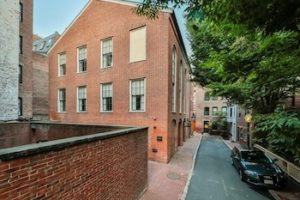
The African Meeting House
*On this date, in 1805, the African Meeting House was founded. Also known as the First African Baptist Church, First Independent Baptist Church, and the Belknap Street Church, it is now the oldest Black church edifice still standing in the United States.
Before 1805, although Black Bostonians could attend white churches, they generally faced discrimination. They were assigned seats only on the balconies and had no voting privileges. Thomas Paul, a Black preacher from New Hampshire, led worship meetings for Blacks at Faneuil Hall. With twenty members, Paul officially formed the First African Baptist Church and purchased a building.
Funds for the African Meeting House came from white and black communities. Cato Gardner, a native of Africa, raised more than $1,500 toward $7,700 to complete the meeting house. A commemorative inscription above the front door reads: "Cato Gardner, first Promoter of this Building 1806." Scipio and Sylvia Dalton helped organize and raise money to build the church. The African Meeting House was completed the following year, and a public dedication was held on December 6, 1806.
In the early 1800s, Primus Hall established a school for blacks in his home. He sought funding from the community, including African sailors, to pay for school expenses. Unsuccessful in establishing a public school with the city of Boston in 1800, he moved his school to the African Meeting House by 1806. The African Meeting House became known as the Black Faneuil Hall during the abolitionist movement. On January 6, 1832, William Lloyd Garrison founded the New England Anti-Slavery Society. The façade of the African Meeting House is an adaptation of a design for a townhouse.
In addition to its religious and educational activities, the meeting house became a place for celebrations and political and anti-slavery meetings. The congregation remodeled the African Meeting House in the 1850s. During the American Civil War, Frederick Douglass and others recruited soldiers for the 54th and 55th Massachusetts Regiments.
At the end of the 19th century, when the black community began to migrate to the South End and Roxbury, the building was sold to a Jewish congregation, Anshei Lubavitch, new immigrants in the city living on Beacon Hill and in the North End. It served as a synagogue until 1972 when the Museum of African American History adapted it as a museum. Adjacent to the African Meeting House is the Education and Technology Center. The Trust for Public Land assisted in acquiring the building when the museum needed space to expand.
It is in the Beacon Hill neighborhood of Boston, Massachusetts, adjacent to the Abiel Smith School. It became a National Historic Landmark in 1974. The current African Meeting House includes the Museum of African American History, which is "dedicated to preserving, conserving and accurately interpreting the contributions of African Americans in New England from the colonial period through the 19th century." The African Meeting House is open to the public as part of the Boston African American National Historic Site.